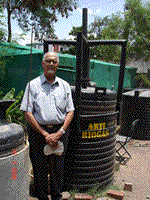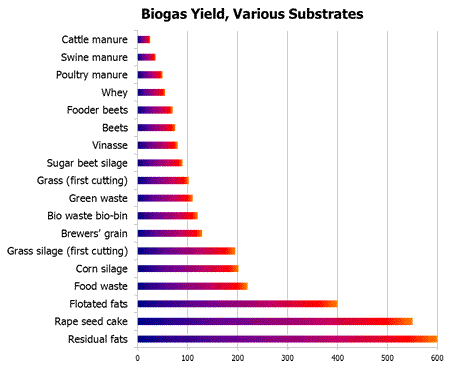
ARTI is the Appropriate Rural Technology Institute, established by Dr. Anand Karve in Maharashtra, India (which is 400 km inland from Mumbai /Bombay). His digester design is really simplicity itself: Take a plastic water tank and cut the top off. Take a smaller plastic water tank and put it upside down inside the first tank. Add a modest bit of plumbing, and there it is. (The unit behind Dr. Karve in the picture is an early design, and so it had a “cage” to constrain the top: the gas-holding, smaller water tank. Subsequent trials showed that having such guides is not necessary.)

“In the old unit some gas
was lost…”
In 2006, ARTI won an Ashden Award for this design, which is topologically identical to a design proposed at least as long ago as 1984, when the second FAO title mentioned on the page about 55-gallon digesters (“Biogas: What it is…”) was published. It showed a digester made from a 30-gallon drum with an open top, inverted into a 55-gallon drum with an open top: a smaller tank inside a larger tank. Interestingly, between the two FAO publications, published a year apart, a bit of evolution apparently took place:
You have already built one or more biogas units like the one described in… “Biogas: what it how it is made; how to use it”…. In this [new] booklet you will learn how to build and use a better small biogas unit like the one shown [on the 55-gallon drum digester page, with an inner tube around it]. It too has an oil drum for a [digester] and, like your first small unit, all the waste [slurry] is put in at one time when you begin. [In other words, the “improved” unit is a batch-fed digester too.]
However, the new unit is closed. A closed unit is cleaner. You cannot smell the waste after you have put it in as you could with your old unit. In addition, with your old unit some of the gas was lost from around the open sides of the [digester tank].
(Of course, if you don’t want or need full output from the digester, you can feed it less. Put it on a diet. But you won't get as much biogas…)
Of course, all digesters have advantages and disadvantages, and the ARTI digester suffers from both of these problems (loss of biogas, and, depending on what it is fed, odor). In “Research on Anaerobic Digestion of Organic Solid Waste at Household Level in Dar es Salaam, Tanzania”, it says:
[In the ARTI digester] …gas loss through the rim between digester and gasholder (approximately 22%) leaves room for improvement, as the emission of biogas reduces the efficiency of the system and spreads undesired greenhouse gases.
In other words, depending on how it’s made, the ARTI design digester loses almost a quarter of the biogas it generates! (As a greenhouse gas, the methane in biogas is more than 33 times as potent as carbon dioxide. It’s not a good thing to release methane into the environment.)
Apparently in a subsequent ARTI design, the inner gas collection tank has been better fitted to the lower digester tank, reducing losses. If you build such a digester, take care to get two tanks that fit properly.
And in any case, as “Technical and Biological Performance of The ARTI Compact Biogas Plant For Kitchen Waste…” mentions:
Although there is some room for improvement, the ARTI biogas system has proven to be technically and environmentally viable.
In another report (“Anaerobic Digestion of Biodegradable Solid Waste in Low- and Middle-Income Countries”) a bit more detail which pertains to the construction of ARTI digesters is given:
The compact plants are made from cut-down high-density polyethylene (HDPE) water tanks, which are adapted using a heat gun and standard HDPE piping. The standard plant uses two tanks, with volumes of typically 0.75m3 and 1m3. The smaller tank is the gas holder and is inverted over the larger one which holds the mixture of decomposing feedstock [ARTI recommends using food wastes] and water (slurry).
An inlet is provided for adding feedstock, and an overflow for removing the digested residue. This contains a much smaller amount of solid matter than the residue from a manure-based plant [digester], and ARTI recommends that the liquid be mixed with the feedstock and recycled into the plant.
A pipe takes the biogas to the kitchen, where it is used with a biogas stove. Such stoves are widely available in India which has a long tradition of using manure-based biogas plants.
The gas holder gradually rises as gas is produced, and sinks
down again as the gas is used for cooking. Weights can be placed on the top
of the gas holder to increase the gas pressure.

One interesting aspect of the ARTI digester is the increased interest it has caused in using food waste and similar substrates. Such materials digest more rapidly and often provide more biogas than the manures which are more widely used. Indeed, it has been said that because these wastes digest faster and provide more gas than comparable dry weights of manure, somehow the ARTI system is itself far, far more “efficient” than manure-based digesters. This, of course, is not the case, because it is not the hardware which creates the difference.
Rather, it is only and solely the use of food waste which leads to the described differences. The hardware used, after all, is very little else than two tanks, one inside the other, and in that sense, as mentioned above, it is functionally identical to several far older digester designs.
Thus any biogas digester fed food waste, or chemically simple, easily-digested substrates such as sugar and flour, will produce biogas in greater quantity and more rapidly as compared with a manure-fed digester.
Of course, this not new information. The fact that some non-manure substrates produce more biogas on any comparable basis has been known nearly a century, if not longer. For example, the eminent researcher A.M. Buswell provided numerous excellent papers about the anaerobic digestion of various substances, starting as early as 1920, and continuing for decades subsequently. (See for example, this paper, or some of his other studies here.)
Recommendation: Unfortunately (at least as we see it), a Google search for more information on ARTI digesters will usually offer this page at Howtopedia [if the site is down click here], the content of this page has improved recently, but better resources are available. (However the link is there; you can judge for yourself.) Instead, we would direct you to the resources mentioned above. As the best free resource of which we know on the web, we would recommend the appendix to one of the reports already mentioned (“Research on Anaerobic Digestion of Organic Solid Waste…”). That appendix is found here. (See the information starting as of the 15th page of the PDF.)
| Next: | How to build an underground masonry digester |
| Previous: | How to build a 55-gallon digester |
